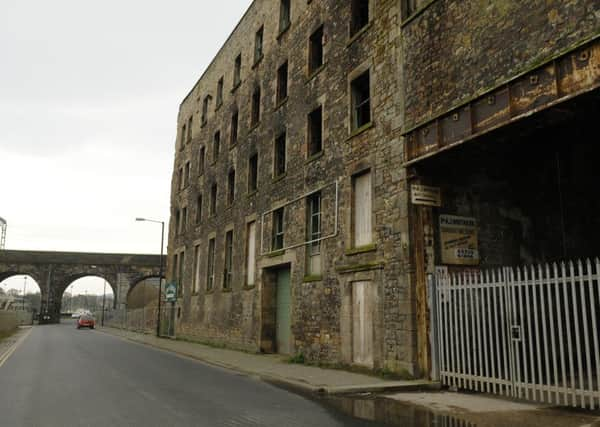Mills and doom: Fight to save Lune buildings


Plans were submitted last month to demolish the former St George’s Works in St George’s Quay to make way for a new student village.
But Lancaster and District Heritage Group feel that despite an arson attack in 2012, in which the interior of the building was severely damaged, the exterior façade remains structurally sound.
Advertisement
Hide AdAdvertisement
Hide AdThe group has applied to Historic England - formerly English Heritage - for the building to be Listed, and therefore preserved, to retain an important part of the city’s industrial past.


Meanwhile, a fight goes on further down the quay to save another historic mill from demolition.
Lancaster Civic Society has objected to the demolition of “redundant industrial buildings” in Thetis Road, which it says are actually in an “excellent state of repair”.
The buildings are also part of the same Lune Mills linoleum manufacturing complex, established by James Williamson in 1871 adjacent to New Quay.
Advertisement
Hide AdAdvertisement
Hide AdApplicants Manchester based Hurstwood Holdings have applied to demolish the three units on the Lune Industrial Estate, and have submitted an outline application to build 263 new homes.


Businesses on the Lune Industrial Estate - including Bay Fabrications, Fireus Ltd, First Subsea Ltd, JL Lancaster, Lune engineering, NC Lancaster, Normesh, STS Manufacturing and Think Pink Skips - have also objected to the plans.
They are worried about the effect the development would have on their businesses, and business and employment in Lancaster in general. A letter of objection states that despite a lack of marketing and investment, the estate is thriving, and the area covered by the proposed development is mostly let and supports around 300 full-time equivalent jobs over the year.
Lancashire Archaeology Advisory Service has also objected to the plans, which it says are “premature” and would not wish to see the “apparently sound Unit 1 being demolished without any obvious justification”.
Advertisement
Hide AdAdvertisement
Hide AdIn a letter to Andrew Dobson, Lancaster City Council’s chief officer for regeneration and planning, Peter Iles, from the organisation said: “The Lune Mills site is considered to be of regional, if not national significance and any proposals which impact surviving elements of the site should be fully documented.”


St George’s Works next to Carlisle railway bridge is a prominent landmark on St George’s Quay, and has recently been used by Network Rail in an advertising campaign promoting Lancaster as a ‘Heritage City’, with large posters at London Euston.
As part of the initial plans for a new student village it was to be kept and incorporated into the 419 bed development, but the plans were changed and resubmitted in September. City councillors decided to give demolition the go-ahead, subject to planning conditions and a legal agreement.
Andrew Reilly, chair of Lancaster and District Heritage Group, said: “We feel at the heritage group, as do many others, that it’s the facade and the actual structure of the building that’s very much worth keeping.
“It’s part of Lancaster’s cultural and historical past.


Advertisement
Hide AdAdvertisement
Hide Ad“James Williamson was one of the biggest employers in Lancaster, and most of the rest of his factory is now flattened or housing estate.
“This is the sole remnant left. We appreciate that it needs developing, but it can be done sympathetically.
“You can use the facade and the structure of the building and build a brand new building inside it. Last week we made an application to Historic England to have the building Listed.
“That basically means that if it is successful, the actual facade of the building will need to be kept.”
Advertisement
Hide AdAdvertisement
Hide AdA spokeswoman for Historic England said: “I can confirm that we have received an application to list St George’s Works Mill in Lancaster, which we are assessing.
“Unfortunately at this stage I cannot give a timescale as to when a decision will be made.”


Much of St George’s Quay has been given over to new housing development, and both Lancaster Civic Society and Lancaster and District Heritage Group feel that at least some of the quay’s heritage should be kept.
Martin Widden, co-chairman of Lancaster Civic Society added: “We are strongly opposed to the demolition of the historic stone-built mill building to the west of the site and believe this should be retained for employment use or adapted for residential use as has been successfully achieved in other areas of the city. A strong case can be made for the preservation of this building, which would appear to be in an excellent state of repair, it being one of the last left standing as a reminder of Lancaster’s industrial heritage as one of the largest linoleum manufacturing plants in Europe.”
Advertisement
Hide AdAdvertisement
Hide AdResponses from members of the public on social media have been mixed.
Joseph Hind said: “It’s an awful building and certainly not worth preserving. Pull it down, don’t want another Kingsway!”
While Ruth Rowlands said: “It’s Lancaster’s history. Preserve it, respect it & learn about it. When it’s gone it’s too late.”
A Lancaster City Council spokeswoman said: “The mill building at Thetis Road was subject to a Prior Approval notification. This is not a planning application. The building is neither Listed nor does it fall within a Conservation Area. Under the Prior Approval process the Local Planning Authority cannot consider anything other than the method of demolition and how the land will be left post-demolition.”